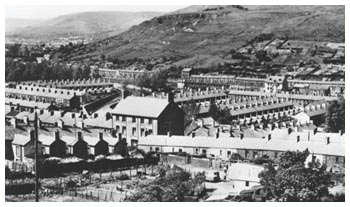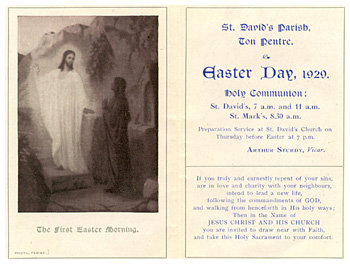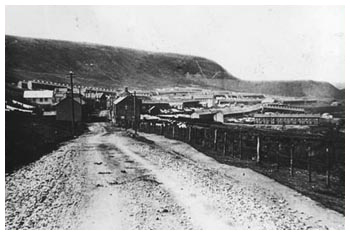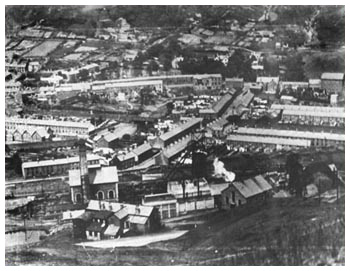
| Gelli | |
 |
The village of Gelli, similar to many of the villages of the Rhondda, takes its name from a farm that existed in the area. The English translation of Gelli could be taken as meaning a small wood, grove or copse. The 1847 tithe map of the area shows a rural area comprising scattered farmsteads such as Ty Isaf, Ynisgoy (Ynys Coy), and Bwllfa owned by landowners such as Crawshay Bailey and the Earl of Dunraven. However archaeological excavations on the hillside above Gelli, particularly at Hen Dre'r Gelli, such as in May 1921 when three bronze age axes were discovered, indicate that this area of the Rhondda had inhabitants from the earliest times of Britain's history. Remains suggest Bronze Age, Iron Age, Romano-British, as well as medieval activity associated with this area of the Rhondda. |
Gelli's origins as the mining village we know today date back to the sinking of the first pit in the area by Edmund Thomas and George Griffiths in the 1870s. John and Richard Cory, who traded as Messrs' Cory Brothers and Company then purchased Gelli Colliery in 1874, deepening it to the steam coal measures in 1877. A gas explosion at the colliery in 1883 killed five and seriously injured twenty other miners at the pit. The colliery was subsequently sold to the Powell Duffryn Steam Coal Company one of the foremost colliery combines in Britain, who retained ownership until Nationalisation of Britain's mines after the Second World War.
|
Nantygwyddon Road prior to 'making up', circa 1910 |
Above: Gelli Colliery and surrounding area, circa 1930. In the shot you can make out Ystrad Road with Ystrad Library, Shady Road, Dorothy Street with old Gelli School, Princess Street, Ynysgau Street, Gelli Crossing, William Street with Nebo Chapel |
It was at Gelli Colliery that the first Miners Federation of Great Britain Lodge was formed in the Rhondda. The first meeting of the lodge at the Gelli Hotel attracted less than fifty miners, but its popularity soon grew with many more joining the fledgling union despite strong opposition from the Cory Brothers. David Davies of Llandinam also sunk the Eastern Colliery at Gelli in 1877, which closed sixty years later in 1937. Although not one of the Rhondda's main shopping centres such as Pentre, Tonypandy or Treorchy the 1926 Kelly's Industrial Directory of South Wales of Gelli gives an image of a busy, thriving mining community. As well as the usual shops, chapels etc. Gelli had its own County police Station where a sergeant and three constables were based, a public elementary school built in 1893 and subsequently expanded in 1894 and 1903, and its own park officially opened in 1919.
|
| Gelli's low-lying position alongside the River Rhondda made it particularly susceptible to flooding. In both 1960 and 1970 particularly severe weather led to many of the streets being inundated with several feet of water, leading the local authority to spend large amounts of money on a flood prevention scheme to prevent any further occurrences in the future. | |
| St.Mark's Church - Gelli | |
In researching the history of St. Mark's we are fortunate to have a book written by Mrs. Muriel Evans in November 1959 that covers in depth .the founding and history of the church. In this work Mrs. Evans explains that unlike the nearby church of St.David's, St.Mark's was not fortunate enough to have a benefactor such as Crawshay Bailey to bear the cost of building the church. As such, ‘The story of the rise of St. Mark's Church is one of hard struggle', and if it was not for the determination of its founder, the Rev. Canon Lewis it's unlikely the church would ever have been built. The Rev. Lewis was vastly experienced in church building, and St. Mark's would have been his twenty-first such project, however, ‘never throughout his career in Ystradyfodwg did Canon Lewis meet more opposition than when putting forward his project for a new church in Gelli'. As early as 1893 Canon Lewis had begun enquiries about leasing a plot of land for a Mission room at Gelli, and in January 1895 he actually acquired a plot in a side street off Gelli Road. Expecting support from the Crawshay Bailey Estate he applied for additional land and commissioned an architect, Mr. Jacob Rees, to prepare plans for a new church. However, in the first of many setbacks, the hoped for support was not forthcoming forcing him to abandon his plans. |
 |
Then in 1896 the Vicar purchased a mission room in Ystrad Terrace, which were vacated by the Welsh Calvinistic Methodists who were themselves moving to new premises on Tyisaf Road. This building became the Mission Church of St. Mark's Gelli and Captain J.R. Davies of the Church Army was placed in charge. In 1900 Canon Lewis had plans drawn up for extending this mission room into a church. He subsequently abandoned these plans, as he wanted a larger church than these would make possible, one that could accommodate 350 people. |
|

